Plas Dwbl
Plas Dwbl was like going back in time 40 or 50 years! I visited very soon after it was bought by ‘The Three Ladies’ in 1978, and made frequent visits to work on building up the farm over the next two years, assisting Katherine Castelliz, under whom I was serving a biodynamic apprenticeship at Coleg Elidyr Camphill, in Rhandirmwyn.
Plasdwbl had been bought by Mary Hayden and Marion Swaddon when they retired from running a very successful boarding hostel on the edge of the Ashdown Forest for pupils of Michael Hall Steiner School in Forest Row, E. Sussex. I remember them telling me the story of how they had come to find Plasdwbl , which seemed to be in the middle of nowhere! Their dear friend and colleague, Nim de Bryn had moved from Forest Row to Wales to help found the first Welsh Steiner School at Nant y Cym, Llanycefn, Clynderwen. They wanted to be within a twenty minute drive from the school so Nim could live with them. So they drew a circle on a map and found Plas Dwbll.
Marion Swaddon – see here for more on Marion – was a remarkable nonagenarian who spent the days hauling stones out of the surrounding fields and assembling walls to extend the living accommodation, slapping on mortar with her bare hands. The evenings found her reading her favourite ‘Philosophy of Spiritual Activity’, and discussing it with anyone available, sitting as close to the large Aga as she could get, whilst sewing very characterful gnomes and dolls to raise funds for the impoverished Nant Y Cym school.
Mary Haydon, mid-eighties,dedicated herself to creating a wonderfully comfortable home and delicious meals for the little community, always interested in everyone who came to stay, and uncomplaining in her endless tasks of bread baking, cheese & butter making, preserves and processing, cleaning & polishing and making nourishing meals from modest essentially home grown ingredients. She had been trained in Home Economics and was a kindly, patient and good-natured woman .
Nim De Bryn, Dutch by birth, had lived and worked for many years with Mary & Marion at the hostel. She was positively youthful in her 50’s (?), although always seemed rather childlike and innocent in her enthusiasm and kindness and concern for ‘the Ladies’. She milked the house cow and helped in the garden, but spent much time preparing her lessons and learning Welsh so she could teach bilingually.
Katherine Castelliz was friends with the above in Forest Row, during her years as farmer at Tablehurst Farm. When they bought Plas Dwbll it was always the plan that Katherine would take on the farming: she was then in her mid-70’s. She had been a researcher working for Weleda in Switzerland and with Ehrenfried Pfeiffer. Having grown up on her family farm in Austria, she always hoped to return to farming. When she transferred to Weleda in England, she had a chance to start farming again after being invited by Francis Edmunds to run Tablehurst Farm. Following a brief time at Peredur Home School, Katherine was asked to go and provide training for the farmers at Coleg Elydyr, She agreed to do so if she could bring her own apprentices along, and that is how I ended up there. After two years she moved to a house in the centre of the village of Clyderwen to run Plas Dwbll farm full time, and employed a local (English) man to do the tractor work. Katherine made quite an effort to be accepted by the not always friendly local farmers. Together with Barbara Saunders Davies (another friend who moved from Forest Row and bought the neighbouring property and land) they all formed the Responsive Earth Trust, and planned to train young people in farming, gardening and farmhouse processing. They began to do so in 1984.
When I first visited it seemed a rather unpromising prospect, with boggy sour land, crumbling stone banks, suffering from decades of overgrazing by sheep. The limited machinery was ancient, and we had to walk the fields spreading lime by hand with a bucket and trowel. We spread the first muck from the link box of the ancient Massey Ferguson tractor by muck fork. But before long they began to create a place of beauty, harmony and culture in what could be a bleak, damp, mizzly West Wales landscape, but which was, when the mists ascended, an atmospheric, beautiful place, with a stone circle across the road, and very close to where the Blue Stones were taken from to Stonehenge.
